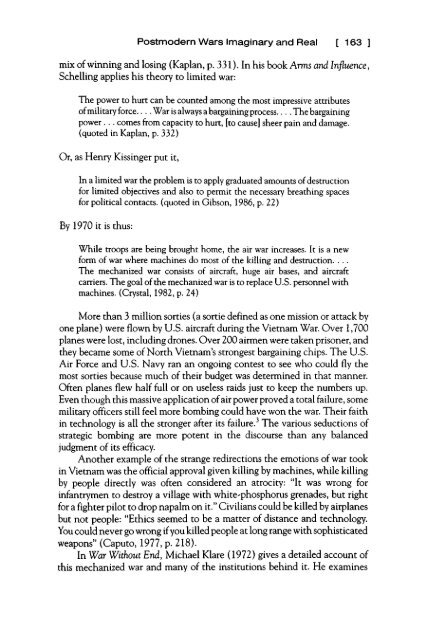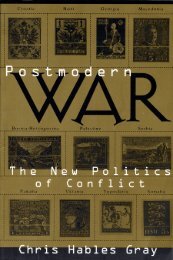Postmodern Wars Imaginary and Real: World War III - Chris Hables ...
Postmodern Wars Imaginary and Real: World War III - Chris Hables ...
Postmodern Wars Imaginary and Real: World War III - Chris Hables ...
You also want an ePaper? Increase the reach of your titles
YUMPU automatically turns print PDFs into web optimized ePapers that Google loves.
<strong>Postmodern</strong> <strong><strong>War</strong>s</strong> <strong>Imaginary</strong> <strong>and</strong> <strong>Real</strong> [ 163 ]<br />
mix of winning <strong>and</strong> losing (Kaplan, p. 331). In his book Arms <strong>and</strong> Influence,<br />
Schelling applies his theory to limited war:<br />
The power to hurt can be counted among the most impressive attributes<br />
of military force.... <strong>War</strong> is always a bargaining process.... The bargaining<br />
power. .. comes fromcapacity to hurt, [to cause] sheer pain <strong>and</strong> damage,<br />
(quoted in Kaplan, p. 332)<br />
Or, as Henry Kissinger put it,<br />
In a limited war the problem is to apply graduated amounts of destruction<br />
for limited objectives <strong>and</strong> also to permit the necessary breathing spaces<br />
for political contacts, (quoted in Gibson, 1986, p. 22)<br />
By 1970 it is thus:<br />
While troops are being brought home, the air war increases. It is a new<br />
form of war where machines do most of the killing <strong>and</strong> destruction. . . .<br />
The mechanized war consists of aircraft, huge air bases, <strong>and</strong> aircraft<br />
carriers. The goal of the mechanized war is to replace U.S. personnel with<br />
machines. (Crystal, 1982, p. 24)<br />
More than 3 million sorties (a sortie defined as one mission or attack by<br />
one plane) were flown by U.S. aircraft during the Vietnam <strong>War</strong>. Over 1,700<br />
planes were lost, including drones. Over 200 airmen were taken prisoner, <strong>and</strong><br />
they became some of North Vietnam's strongest bargaining chips. The U.S.<br />
Air Force <strong>and</strong> U.S. Navy ran an ongoing contest to see who could fly the<br />
most sorties because much of their budget was determined in that manner.<br />
Often planes flew half full or on useless raids just to keep the numbers up.<br />
Even though this massive application of air power proved a total failure, some<br />
military officers still feel more bombing could have won the war. Their faith<br />
in technology is all the stronger after its failure. 3 The various seductions of<br />
strategic bombing are more potent in the discourse than any balanced<br />
judgment of its efficacy.<br />
Another example of the strange redirections the emotions of war took<br />
in Vietnam was the official approval given killing by machines, while killing<br />
by people directly was often considered an atrocity: "It was wrong for<br />
infantrymen to destroy a village with white-phosphorus grenades, but right<br />
for a fighter pilot to drop napalm on it." Civilians could be killed by airplanes<br />
but not people: "Ethics seemed to be a matter of distance <strong>and</strong> technology.<br />
You could never go wrong if you killed people at long range with sophisticated<br />
weapons" (Caputo, 1977, p. 218).<br />
In <strong>War</strong> Without End, Michael Klare (1972) gives a detailed account of<br />
this mechanized war <strong>and</strong> many of the institutions behind it. He examines








